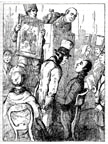 ankruptcy looms as a horrifying possibility or tragic fact in many Victorian novels, including Thackeray's Vanity Fair, Dickens's Little Dorrit, Gaskell's North and South, and Reade's Hard Cash. In an age that lacked almost all forms of modern social security, the threat of becoming a bankrupt was extremely serious — even after the closure of the debtor's prisons that Dickens anachronistically depicted in Little Dorrit. With good reason Victorian novelists represent the bankrupt as a person shipwrecked and castaway, a human being helpless against indifferent forces of nature.
ankruptcy looms as a horrifying possibility or tragic fact in many Victorian novels, including Thackeray's Vanity Fair, Dickens's Little Dorrit, Gaskell's North and South, and Reade's Hard Cash. In an age that lacked almost all forms of modern social security, the threat of becoming a bankrupt was extremely serious — even after the closure of the debtor's prisons that Dickens anachronistically depicted in Little Dorrit. With good reason Victorian novelists represent the bankrupt as a person shipwrecked and castaway, a human being helpless against indifferent forces of nature.
An Elephant for Sale by W. M. Thackeray. [Click on thumbnail for larger image.]
Thackeray presented — and reinforced — a common fear among the middle-classes when he depicts a family whose belongings are suddenly taken away from them and sold at auction. Thackeray's own illustration for his novel enforces the essential vulgarity of the situation: auctioneers with no knowledge of the family or the sentimental meaning of its possessions expose them to a heartless public. Dobbin, who has chivalrously come to the auction to buy back some of the Sedleys' things, appears as the helpless young gentleman threatened by auctioneer and his two helpers, one of whom looms over him.
Granted, the threat of becoming a bankrupt could be terrifying, but how likely was such personal economic disaster to occur? The political, economic, and social historian Eric Hobsbawm argues that
A man might have to work hard to raise himself into the middle class, but once in a moderately flourishing line of business, he could take things very easily indeed, unless he made some appalling miscalculation, or hit an abnormally bad patch in the course of an abnormally bad slump. Bankruptcy was, according to economic theory, the penalty of inefficient businessmen, and its spectre haunts the novels of Victorian England. But in fact the risks of incurring it were extremely modest, except for the very tiny and marginal man in such occupations as small shopkeeping, the fringes of the building trade, and the underside of a few still dynamic industries such as metals. [161-62]
Hobsbawm claims that the threat of bankruptcy was "negligible" in major industries during the three decades before World War. He cites as evidence the fact that even during a period of depression (1905-9) less than one half of one percent of cotton manufacturers failed each year. He concludes: "Freed from the spectre of sudden impoverishment and social ostracism — the very horror of bankruptcy is itself a symptom of its comparative rarity — the British businessman did not need to work much" (162).
Hobsbawm's argument prompts several questions and observations:
•The Victorian middle classes, particularly their upper divisions, worked far less hard than either the contemporary working classes or twentieth- and twenty-first-century middle and professional classes.
•Hobsbawm draws much of his evidence, not from prosperous periods, but from the decades that marked the Great Depression (1873-96). This fact makes his case even stronger.
• At the same time, Hobsbawm, who writes from the vantage point of the left, has a vested interest in claiming that the middle classes had a particularly easy time of it. Of course, such a predilection may enable him to notice something others have overlooked.
•Can one apply Hobsbawm's claim to early and mid-Victorian years as well?
•If bankruptcy was comparatively rare as he claims, how does one explain its frequent occurrence in Victorian fiction?
•Is bankruptcy (and the fate of the bankrupt) a Victorian socio-political myth more than an economic reality? How would one decide such a question? that is, what evidence does the question demand?
•Does historical accuracy or statistical proof matter?
Related materials
- Mid-Victorian England's Industrial Dominance — and the First Great Depression
- How Victorians Could Invested Their Capital
- Wages, the Cost of Living, Contemporary Equivalents to Victorian Money
References
Hobsbawm, Eric. Industry and Empire: The Birth of the Industrial Revolution. rev. ed. New York: New Press, 1999.
Last modified 22 March 2001
